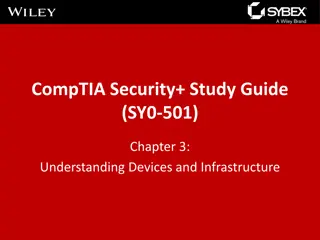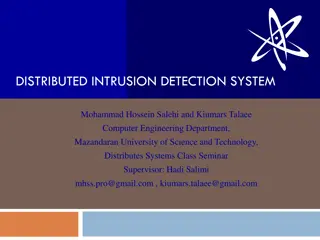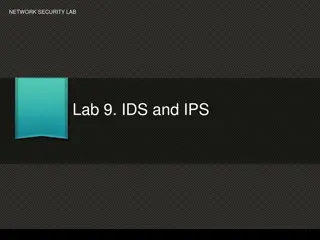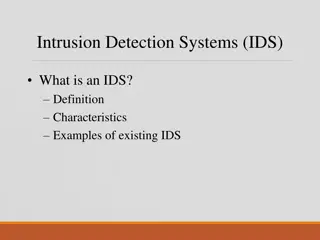
Intrusion Detection Systems (IDS)
Learn about Intrusion Detection Systems (IDS), including the different types such as anomaly detection and signature-based systems. Discover how IDS works to detect unwanted network traffic and potential security breaches effectively.
Download Presentation

Please find below an Image/Link to download the presentation.
The content on the website is provided AS IS for your information and personal use only. It may not be sold, licensed, or shared on other websites without obtaining consent from the author. If you encounter any issues during the download, it is possible that the publisher has removed the file from their server.
You are allowed to download the files provided on this website for personal or commercial use, subject to the condition that they are used lawfully. All files are the property of their respective owners.
The content on the website is provided AS IS for your information and personal use only. It may not be sold, licensed, or shared on other websites without obtaining consent from the author.
E N D
Presentation Transcript
www.studymafia.org Seminar On Intrusion Detection Systems (IDS) Submitted To: www.studymafia.org www.studymafia.org Submitted By:
What is IDS Intrusion Detection Systems (IDS) Anomaly detection Signature based misuse Host based Network based Benefits of IDS Future of IDS
Intrusion detection is the act of detecting unwanted traffic on a network or a device. An IDS can be a piece of installed software or a physical appliance that monitors network traffic in order to detect unwanted activity and events such as illegal and malicious traffic, traffic that violates security policy, and traffic that violates acceptable use policies. Intrusions are the activities that violate the security policy of system. Intrusion Detection is the process used to identify intrusions.
Different ways of classifying an IDS IDS based on anomaly detection signature based misuse host based network based
This IDS models the normal usage of the network as a noise characterization. Anything distinct from the noise is assumed to be an intrusion activity. E.g flooding a host with lots of packet. The primary strength is its ability to recognize novel attacks.
Assumes that intrusions will be accompanied by manifestations that are sufficiently unusual so as to permit detection. These generate many false alarms and hence compromise the effectiveness of the IDS.
This IDS possess an attacked description that can be matched to sensed attack manifestations. The question of what information is relevant to an IDS depends upon what it is trying to detect. E.g DNS, FTP etc.
ID system is programmed to interpret a certain series of packets, or a certain piece of data contained in those packets,as an attack. For example, an IDS that watches web servers might be programmed to look for the string phf as an indicator of a CGI program attack. Most signature analysis systems are based off of simple pattern matching algorithms. In most cases, the IDS simply looks for a sub string within a stream of data carried by network packets. When it finds this sub string (for example, the ``phf'' in ``GET /cgi-bin/phf?''), it identifies those network packets as vehicles of an attack.
They are unable to detect novel attacks. Suffer from false alarms. Have to programmed again for every new pattern to be detected.
The host operating system or the application logs in the audit information. These audit information includes events like the use of identification and authentication mechanisms (logins etc.) , file opens and program executions, admin activities etc. This audit is then analyzed to detect trails of intrusion. Host-based intrusion detection systems (HIDS) analyze network traffic and system-specific settings such as software calls, local security policy, local log audits, and more. A HIDS must be installed on each machine and requires configuration specific to that operating system and software.
The kind of information needed to be logged in is a matter of experience. Unselective logging of messages may greatly increase the audit and analysis burdens. Selective logging runs the risk that attack manifestations could be missed.
Attack verification System specific activity Encrypted and switch environments Monitoring key components Near Real-Time detection and response. No additional hardware
They are integrated closely with the TCP/IP stack, allowing packets to be watched as they traverse their way up the OSI layers. This allows the IDS to pull the packets from the stack before the OS or the application have a chance to process the packets.
A Network Intrusion Detection System (NIDS) is one common type of IDS that analyzes network traffic at all layers of the Open Systems Interconnection (OSI) model and makes decisions about the purpose of the traffic, analyzing for suspicious activity. Most NIDSs are easy to deploy on a network and can often view traffic from many systems at once. A term becoming more widely used by vendors is Wireless Intrusion Prevention System (WIPS) to describe a network device that monitors and analyzes the wireless radio spectrum in a network for intrusions and performs countermeasures.
Cost of ownership reduced Packet analysis Evidence removal Real time detection and response Malicious intent detection Complement and verification Operating system independence
Monitors the operation of firewalls, routers, key management servers and files critical to other security mechanisms. Allows administrator to tune, organize and comprehend often incomprehensible operating system audit trails and other logs. Can make the security management of systems by non-expert staff possible by providing nice user friendly interface. Can recognize and report alterations to data files.
To integrate the network and host based IDS for better detection. Developing IDS schemes for detecting novel attacks rather than individual instantiations.
www.google.com www.wikipedia.com www.studymafia.org






















